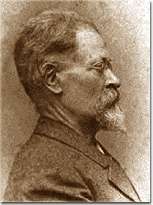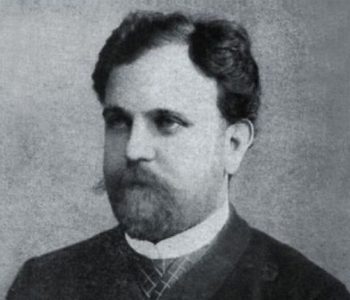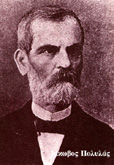
LALLA ROMANO
DIARY OF GREECE
Chapters 1 – 4
Introduction by R. Nicolì
This digital edition of the POLYSEMI Library presents the transcription of some famous pages taken from the Diary of Greece by Lalla Romano; these are contained, together with the author’s entire works, in Works, two volumes edited by Cesare Segre and published by Arnoldo Mondadori in 1991 and 1992 respectively.
Almost twenty years after her death, various conferences, publications and exhibitions have brought their attention to one of the most compelling writers in contemporary Italian literature. Originally from Cuneo but raised in the circle of Turin’s cultural élite of the 1930s, Romano unravelled her creative path over fifty years. Her production escapes any categorization and possibility of being ascribed, at least rigidly, to a specific ‘literary current’.
Her literary life was shy, her writings were characterized by an essential stylistic balance. The writer, as Ferroni states, “si situa in un civile e pacato orizzonte borgese, che si difende e resiste al turbine ossessivo della vita contemporanea”.[1] Like Ferroni, many other criticians and writers (from Eugenio Montale to Carlo Bo, from Italo Calvino to Pier Paolo Pasolini) have attempted to identify the interpretative keys of her production, highlighting the testing ground of her writing which is often placed between the visual language of the image and the verbal language of literature[2], as well as the constant correspondence between her writing and an attentive gaze continually turned to the world.
The story of her journey along the Italian Adriatic coast to Brindisi and then Greece, which she surprisingly tells without any obligatory references to its myths, took place in 1957 and the fifty-year-old writer from Cuneo published its report for the first time two years later.[3] Calvino immediately underlined “l’aerea semplicità di stile” and its “continuo dialogo con le meditazioni di Pavese sul mito e i luoghi”. It is, as the title suggests, a real diary in which at the top of the pages the date, time and place reference mark its movements and whose prose, which is agile and clear, is always characterized by short descriptive choices. It is a minute recording of small events, even short journeys along the route or minimal things both seen and heard, told in first person, from a single point of view, and reported in an ever-controlled prose. Although the travel diary represents a previously established model, the one by Romano escapes any previous references thus unvealing her own literary education and often also the features of her solid artistic consciousness.
It is April, the writer and her husband Stefano, companion of many trips that she defines as “fonte di visione, di avventure”, leave from Milan to Puglia by train. From Brindisi, on the days preceding Easter, they would embark for Greece.
“Il treno è foderato internamente in cuoio scuro, impresso a disegni floreali. […] Il nostro scompartimento è angusto, ammobiliato, vestito; tempestato di borchie, ganci, rampini lucidi di ottone. Anche la scaletta mobile, ridicolmente piccola, è interamente rivestita di panno blu a disegni”. This is the beginning of the Diary, the liminal place of the text in which the author introduces the scene to the reader, “Ai dettagli dello scompartimento va la prima e più infantile curiosità della viaggiatrice (tappezzeria, borchie, lavabo, saponetta)”[4]; in the wagon, the velvet interiors – this time blue – recall those of the “simbolo di tutti i viaggi”, the first train journey to Montecarlo that her father had immortalized in photos, then collected and commented on by the writer many years later[5]. Moving south and passing through Parma, Romano seems to know how to read her husband’s mind: he is tied to that city, the look that the man turns to the dome of the Baptistery from the window and his silence are charged with communicative potential.
The arrival in Puglia is described in the second chapter: “Ogni campagna intravveduta all’alba dal buio e dal chiuso di un treno è una apparizione di purezza”; however, the coloristic aspects are the ones that produce the deepest impression in her, satisfying that peculiar taste for image which can be found in her pictorial inclinations: the green gold of the vine and the fig tree, the light blue sky, the white facade of the Cathedral of Trani, the intense red of the poppy fields.
Regarding Bari, the city whose history overlaps more than any other cities in Puglia with that of the Levant, Romano captures its double face: too “milanese” in its new part, also for the Motta’s sign which homologates it to the northern cities, poor in the innermost folds of the old part where, under the majestic imposition of the Cathedral, it witnesses a “trasloco di poveri” whose “mobili miseri vengono calati dal balcone” and where it perceives all the meandering “white” misery between the freshly plastered houses, among the narrow alleys cheered by the naive and light presence of children.
The link between narration and memory, between history and memory, is captured in the glimmer of perception in a square which is “irregolare, strana, meravigliosa”, a theatrical scene of a concluded market with scenic objects – the remains of unsold vegetables, which Romano feels she has already visited, as a child “quasi l’avessi davvero attraversata, tanti anni fa, un giorno di passeggiata scolastica, “in fila”, she writes. The past is, in general, enlivened through a sort of emotional invasion that takes place in the space of the present. The settled memories re-emerge to re-elaborate the autobiographical experience in a narrative key, like in front of the Laterza publishing house: “Le edizioni Laterza sono state il latte, per noi. Vagheggiate, centellinate nelle biblioteche al tempo dell’adolescenza squattrinata, poi i primi gelosi acquisti: l’Estetica di Croce, la Nascita della tragedia”. However, what was supposed to be a positive symbol of the city, in Romano’s secular perspective, betrays its nature by also offering itself to trade in statues of saints and catechisms, which invade most of its windows, relegating “the real Laterza” to a space reduced by a “sottile rarefatto silenzio del pensiero laico”. Laterza, the cornerstone of Bari’s culture, is often the subject of a digression by travelers in transit in the city of Puglia. 1957, the year of Romano’s trip to Greece and her passage through Bari, is also the year of the first publication of Piovene ‘s Viaggio in Italia[6] who, albeit not stopping at the windows but deciding to check the archives, writes about the famous publishing house:
La cultura barese fa perno nella casa editrice Laterza, che pubblicò e pubblica le opere di Benedetto Croce. Giacché fu l’unica in Italia che mise in commercio opere filosofiche e letterarie fondamentali, serve come nessun’altra a conoscere con sincerità la diffusione reale di alcuni studi, ed a sentire il polso della nostra cultura. Uno sguardo ai registri per esempio ci informa che di Aristotele sono state vendute mille copie in vent’anni, cinquanta copie all’anno. Si dovrebbe dunque supporre che alcuni insegnanti di filosofia si accontentino anch’essi di conoscerlo indirettamente.[7]
In Brindisi, where they will embark on the Angelika, an anticipation of Greece is to be found in the face of a host; however, it is well worth considering the suggestions derived from a vision of the sea, which is pure and immediate, which Romano modulates by crossing it with the theme of the journey: «Vi è laggiù un senso di pace e di silenzio. Il mare, calmo, è esso stesso elemento del silenzio, è uno spazio incorporeo, una eterea pianura che introduce a un viaggio al di là del tempo». Silence therefore has the same value as what is not written on the page or the non-color on the canvas, it is a space for personal elaboration of the lived. On silence, here determined by the quiet of the sea that they will have to cross, Romano would write in her 1987 novel, Nei Mari Estremi: “Per me scrivere è stato sempre cogliere, dal tessuto fitto e complesso della vita qualche immagine, dal rumore del mondo qualche nota, e circondarle di silenzio”[8]. And among all, we recall the observations by Montale, who wrote that Lalla Romano “si è sempre mantenuta fedele a quella che potrebbe dirsi l’arte del silenzio”[9], understood as the capacity to grasp its evocative potential among the din of the world. Due to the lack of sounds that precedes the departure, disturbing noises “il ronfare sordo sotterraneo della nave, il martellare del finestrino che sbatte” are opposed along the journey on the Angelika. Silence would return to Corfu to wrap the Achilleion and reawaken the memory of the Pascolian verses, sent to memory only for the sake of their sound, without awareness, when the adolescent writer believed that Greece was “a book”.
Lalla Romano’s Greece, with very little space dedicated to the description of ancient vestiges and the almost total absence of references to classical myths[10], presents, in the traveller’s writings, aspects that no tourist would ever grasp. Notwithstanding this, it is a touristically organized travel, with small trips arranged in jeeps and ferries, with the presence of local guides who offer ready-made stories about the places, sometimes hindering the visitor’s autonomy. As she wrote many years later, in 1982, in her introductory essay to the volume of the Italian Touring Club Finland, Norway, Sweden: “con tutto rispetto per i gusti altrui, io detesto la visione ‘turistica’ del mondo”. Hers is an attitude, which already clearly emerges from these pages of the Diary, from her insistence on perhaps the most obvious presence around that small portion of Greece represented by the Ionian Islands, that of the sea, “Un mare liscio come un lago”, which predisposes to contemplation and in which the islands become a metaphor for immobility, appearing as “statue che si debbono aggirare”, restoring a sense of fixity in an immovable dimension.
Hence, nothing touristically-predictable casts doubt on the clarity of her Diary; however, we are at the first dawn of what would become a long-lasting season of mass tourism, and the author rather seems to undertake a mature pilgrimage to the idealized places during the years of high school. Moreover, Arbasino would similarly resort to the more bookish high-school memoirs, at the same time, to look at Greece too with disenchanted eyes, perhaps weighed down by the vast classical knowledge which, to some extent predisposes, clashing, as happens in Lalla Romano, with what the Greek landscape offers as possibility of immediate and subtle response to the inner reactions by those who discover it.
The admiration for Greece could reveal and cover many aspects and have lots of meanings; from those of the myth, to the research of a nature capable of allowing a happiness which would elsewhere be impossible. Lalla Romano chooses instead to free herself from “cognizioni e condizioni, schermi culturali e schemi di classe”[11], to acquire a look of more acute and personal penetration of places.
-
Giulio Ferroni, Profilo storico della Letteratura italiana, Einaudi, Milan, 2000, vol. 2, p. 1141. ↑
-
Cfr. Marino Toni, Paratesti figurativi al femminile: il caso di Lalla Romano, in La Letteratura degli Italiani. Rotte confini passaggi, Proceedings of the 14th National ADI Congress, Genoa, 15-18 September 2010, edited by Alberto Beniscelli, Quinto Marini, Luigi Surdich, electronic edition available at the link http://www.italianisti.it/upload/userfiles/files/Marino%20Toni_1.pdf (last accessed: 12 July 2019). ↑
-
A larger version of The Greek Diary was published for Einaudi in 1974. The most recent reissue again for Einaudi, was published in 2013 and edited by Antonio Ria, and also contains Le lune di Hvar e altri racconti di viaggio. ↑
-
Giulia Dell’Aquila, L’Adriatico di Lalla Romano, in Il viaggio Adriatico. Aggiornamenti bibliografici sulla letteratura di viaggio in Albania e nelle terre dell’Adriatico, Proceedings of the 1st International CISVA Conference, Tirana, 1-2 June 2010, Scutari, 3 June 2010, edited by Giovanni Sega, p. 458. ↑
-
Lalla Romano, Nuovo romanzo di figure, Einaudi, Turin, 1997. ↑
-
The journey took place between May 1953 and October 1956. ↑
-
Guido Piovene, Viaggio in Italia, Bompiani, Milan, 2017, p. 738. ↑
-
Lalla Romano, Nei mari estremi, New Edition, Einaudi, Turin 1996, p. 75. ↑
-
Eugenio Montale, Il secondo mestiere. Prose 1920-1979, A. Mondadori, Milan, 1996, vol. 2, p. 2921. ↑
-
The influence of classicism in the Diary of Greece, as well as in The penumbra that we have crossed, is well investigated in the essay by Massimo Gioseffi , Didone rediscovered, in Lalla Romano, a writer in Milan. Conference Proceedings, 1-8 June 2007 – University of Milan, edited by Giuliana Nuvoli, Franco Cesati, Milan/Florence, 2012, pp. 63-89. ↑
-
Vincenzo Consolo, Et in Arcadia Lalla, in A. Ria (edited by), Intorno a Lalla Romano. Saggi critici e testimonianze,
Mondadori, Milan, 1996, p. 223. ↑






